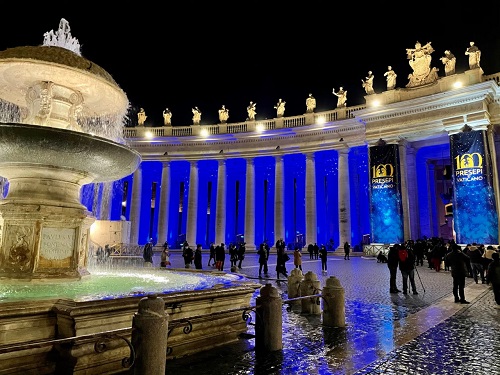Nativity scenes coming from 22 countries around the world: exhibition in the Vatican
VATICAN CITY – There is the Nativity scene from Japan, made with Japanese paper, silk kimonos and tatami mats. And then the Brazilian one, made with coconut and banana fibres. But also the Neapolitan one, in wood and bark. The seventh edition of the International Exhibition “100 Nativity Scenes in the Vatican” promises to be particularly original, with very particular and different artistic representations of the birth of Jesus Christ (that’s “Nativity” in the Catholic religion meaning: in Italy it’s called “Presepe” and it’s an ancient hallmark of the Italian Christmas).
The event brings together works created by artists from all over the world, who have expressed their creativity in the representation of Nativity scenes. Many of the works present this year are inspired by the theme of “Hope does not disappoint”, from the title of the Bull of Indiction of the Holy Year (you can read it here, in English: SPES NON CONFUNDIT): the exhibition takes place this year in conjunction with the Opening of the Jubilee 2025 and it’s part of the stages of the “Jubilee is Culture” exhibition.
The inauguration, open to all, will be held on Sunday 8 December at 4pm at Bernini’s left-hand colonnade (in the pic above, from the official website of the event – www.100presepi.va), in St. Peter’s Square in Rome, where, as tradition, the exhibition is visited every year by tens of thousands of people from all over the world.
“This unique scenario places the numerous Nativity scenes, true works of art, in a frame that invites the visitor even more to marvel at the traditional scene of the Nativity of Jesus and to prepare the heart for the imminent start of the Jubilee, scheduled for on December 24, 2024, Christmas Eve”, we read on the official website of the event.
The exhibition will be inaugurated by Monsignor Rino Fisichella, pro-prefect of the Dicastery for Evangelization of the Vatican, and responsible for the organization of the Jubilee, together with some members of the Dicastery and a representative of the Municipality of Roma Capitale (the event is in collaboration with the City of Rome).
The ceremony will be enlivened by the concert of Christmas songs by the Choir of the Music School of the Chateaubriand French School of Rome and by the musical band of the Vatican City State Gendarmerie Corps, which will accompany the event with some official songs, making the event even more evocative.
But let’s go back to the Nativity scenes: this year 125 will be on display, coming from various European countries, such as France, San Marino, Croatia, Poland, Germany, Hungary, the Czech Republic, Slovakia, Slovenia, Spain, and around the world, such as the United States, Costa Rica, Venezuela, Brazil, Mali, Japan, Philippines, Taiwan, Paraguay. Many of these nations are represented by their respective embassies to the Holy See, who have taken it upon themselves to promote the event in their countries. Among these are the Embassies of France, San Marino, Croatia, Poland, Hungary, Slovakia, Slovenia, Taiwan and Paraguay.
The Nativity scenes summarize the inspiration and imagination of the artists who create them with very different materials, such as Japanese paper, silk, resin, polystyrene, wool, coconut and banana fibre, and glass. Among the artefacts, coming from all over the world, there is the “Jubilee Boat”, a nativity scene produced by the artists of the “Città dei Presepi” Association of Florence, which takes up the symbolism of the Jubilee logo. Then, the Nativity of the Saint Mary Cathedral of Osaka (at the exhibition on the occasion of the collaboration for the presence of the Holy See Pavilion at Expo Osaka 2025) represented with typical materials of the Japanese country, such as Japanese paper, silk kimonos and mats of tatami. And then – as we said at the beginning – the Nativity scene from the Sanctuary of Christ the Redeemer, in Rio de Janeiro, made with natural materials, including coconut and banana fibre, and the Neapolitan-style Nativity too, made of wood and bark from Caserta section of the Italian Blind Union.
The exhibition will remain open from 4pm on Sunday 8 December 2024 to 7.30pm on Monday 6 January 2025. Entry for the entire duration of the exhibition will be free and without the need for reservations. The exhibition will be open every day, from 10am to 7.30pm, except for 24 December and 31 December, when the closing time will be brought forward to 5pm. The last entry is always expected no later than 15 minutes before the closing time. The volunteers of the Dicastery for Evangelization will be present for the entire duration of the event to offer a welcome service.
All detailed information can be found on the official website of the event, here again: www.100presepi.va/en.html
In the video below, a review of some of the Nativity scenes exhibited in a previous edition of the exhibition



